
High Seas Fleet Surrender in the Forth November 1918
Signing of the Armistice
After the Battle of Jutland, the biggest North Sea Naval Battle of WWI in June 1916, Germany resumed unconditional submarine warfare.
On April 2, 1917, President Woodrow Wilson went before a joint session of Congress to request a declaration of war against Germany. Wilson cited Germany’s violation of its pledge to suspend unrestricted submarine warfare in the North Atlantic and the Mediterranean, as well as its attempts to entice Mexico into an alliance against the United States, as his reasons for declaring war. On April 4, 1917, the U.S. Senate voted in support of the measure to declare war on Germany. The House concurred two days later.
In December 1917 the U.S. Navy sent six battleships to replace the British battleships lost at Jutland. They were initially based at Scapa Flow.
The losses to submarine attacks were greatly reduced by the introduction of the convoy system
As US troops poured into Europe in the summer of 1918, and the effects of the naval blockade bit more deeply, (for example when aeroplanes were shot down, the Germans salvaged their engines for lubricating oil) it became clear to Germany that they were losing the war.
The Forth Defences were revised again, to allow ships to anchor to the East of the Forth Bridge. The entire Grand Fleet – Battleships, Battle-cruisers and Destroyers could now be accommodated in the Forth. Jellicoe had retired, and Beatty now had the entire fleet under his command.
Diplomatic efforts had been made during 1918 to reach a cease-fire agreement.
By October 1918 armistice conditions were being discussed. These involved a cease fire, immediate cessation of submarine warfare, and the surrender of the most modern elements of the High Seas Fleet to a neutral power.
The German Navy were not happy with these demands. They recalled their submarines, with the intention of having one more pitched battle with the Grand Fleet. The order to put to sea was issued on 27th of October 1918. But many of the sailors did not turn up for duty, went on strike or mutinied. They felt that they were being sacrificed to sabotage the Armistice terms. The attempt was called off on 29th of October.
The Armistice was finally signed on Monday 11th November 1918, coming into effect at 11.00 that day (Paris time.)
The document included these paragraphs relating to Naval Matters
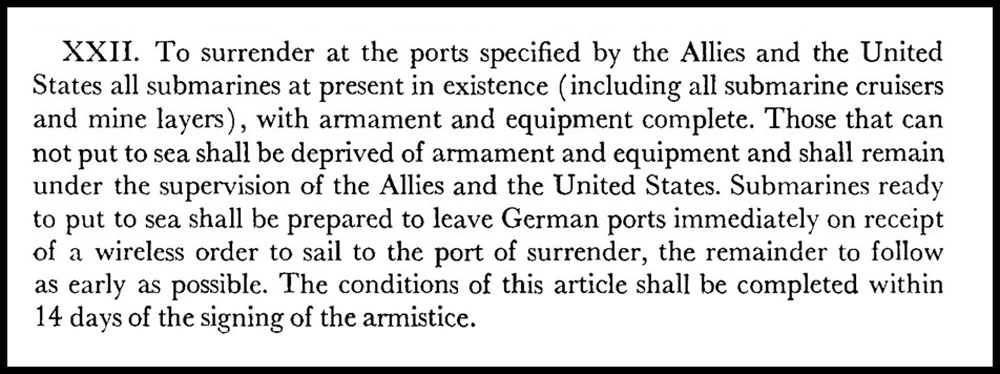

Instructions given to the German Navy
At noon on November 13, Admiral Beatty received a message that Admiral Meurer would act as negotiator for the German navy and would come to Rosyth in the light cruiser Koenigsberg.
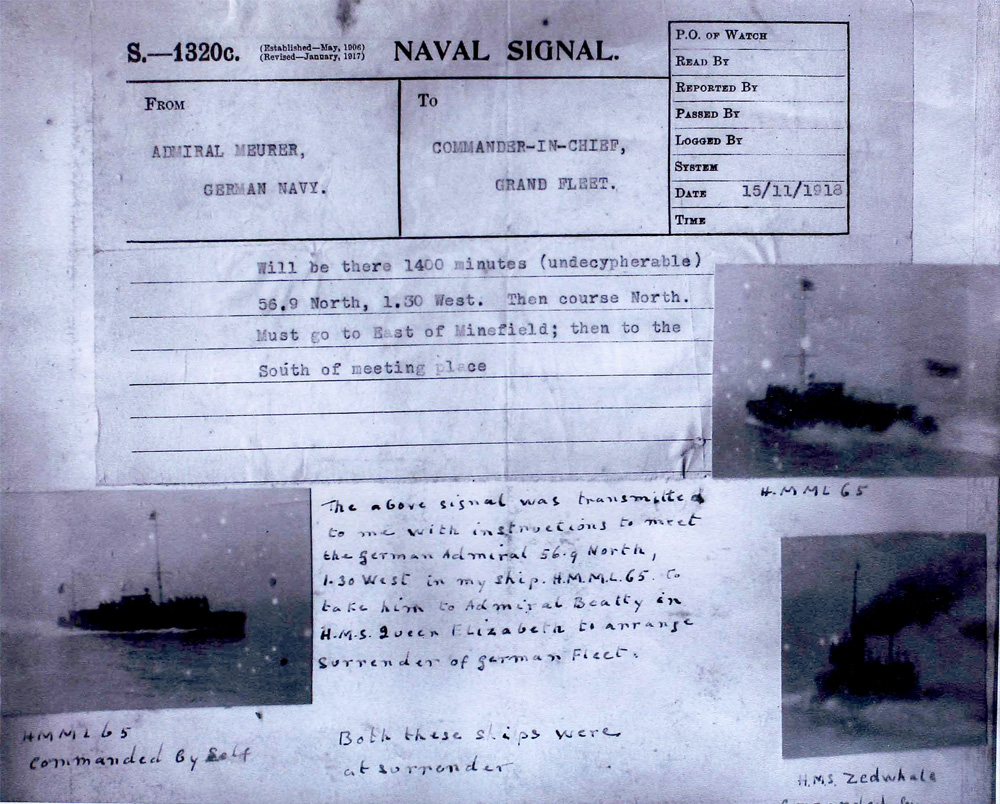
On the foggy evening of Friday 15th November 1918 Meurer arrived in the Forth and was escorted to the Queen Elizabeth, Beatty’s flagship.

There he was presented with a surrender document. One column listed the armistice conditions, the second column listed questions he was to answer and orders with which he was to comply.
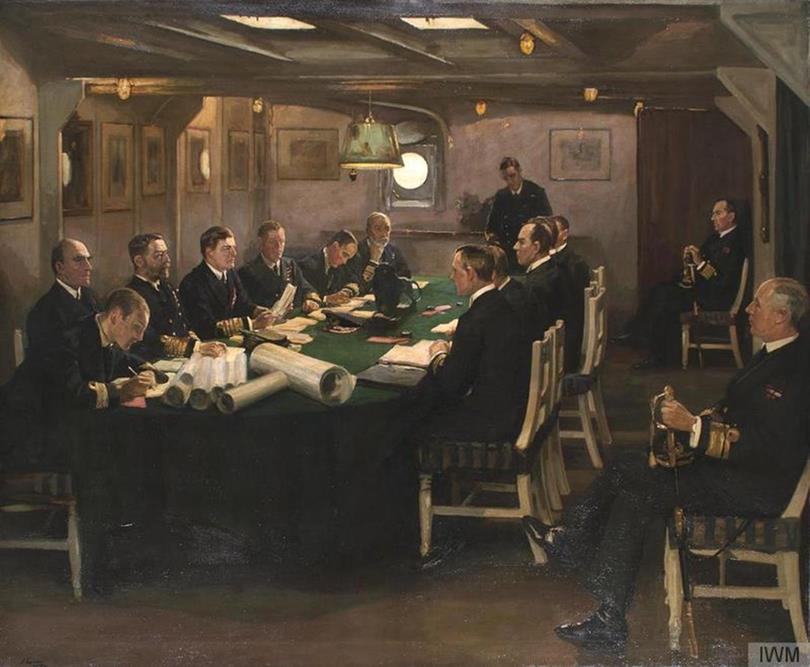
Three more meetings were held on Saturday 16th November 1918 relating to details of the ships to be surrendered, where they would rendezvous, supplies and fuel they could carry, how the crew would be returned, and where the ships would be interned. The ships were to be completely unarmed. Once agreement was reached, Meurer sailed back to Germany that evening.
Surrender of the U-boats
On Tuesday 19th November 1918 the first batch of twenty submarines arrived off Harwich, and were escorted by Admiral Tyrwhitt’s destroyers. They anchored off shore, were inspected and their crews transferred to a German cruiser for immediate repatriation. British crews then took the submarines into port. There was no fraternization or jubilation.

Surrender of the surface ships
On the afternoon of 20th November 1918 King George V and Queen Mary reviewed the Grand Fleet in the Forth. Every available ship had been prepared in readiness for the surrender proceedings.
Meantime the High Seas Fleet had sailed under the command of Admiral von Reuter and were about 100 miles off May Island by midnight on the 20th November. The Grand Fleet set sail on the morning of Thursday 21st November 1918 to meet the High Seas fleet which was led in by HMS Cardiff.

The Grand fleet formed two lines on either side of the High Seas Fleet, then executed a battle turn and escorted the Germans into the Forth.
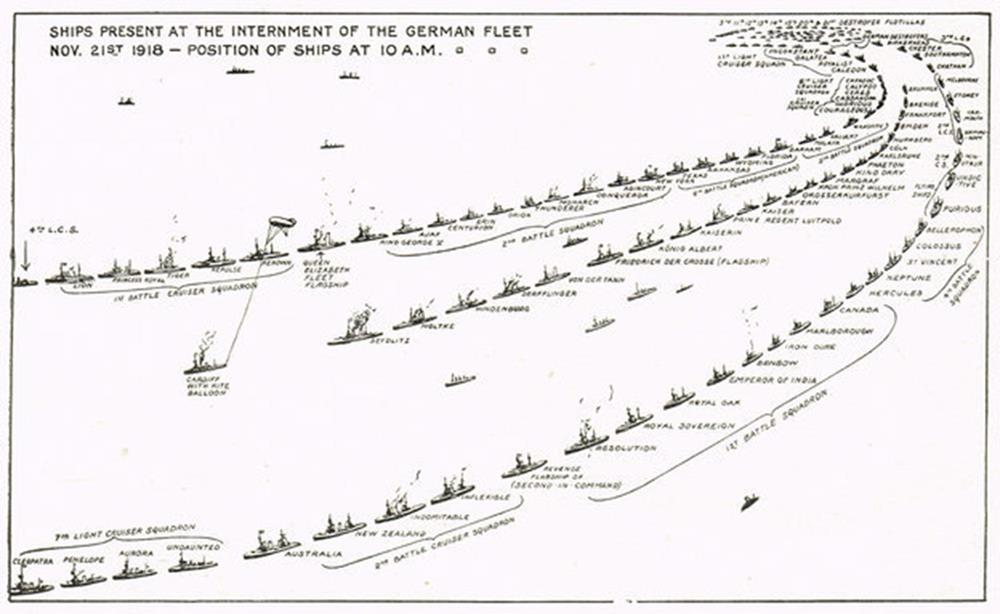
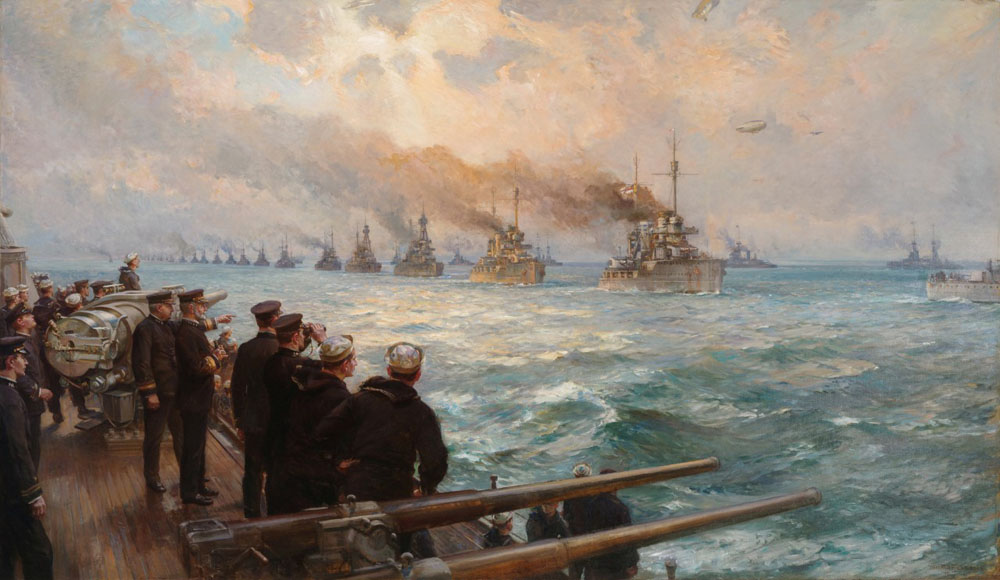
Admiral Rodman watching the surrender

The German Fleet in the Forth

The German Fleet at Anchor off Inchkeith, Firth of Forth, after the Surrender, 22nd November 1918
The combination of the High Seas Fleet and the Grand Fleet was the largest collection of battle-ships ever assembled in one place.
Once the ships of the High Seas Fleet were anchored in the middle of the Forth, Beatty ordered that the German Flag be hauled down, and the Grand Fleet headed on to their anchorage at Rosyth. As the Queen Elizabeth steamed past the Grand Fleet to her anchorage, Admiral Beatty was loudly cheered by the crews.
During the course of the afternoon Commodore M. H. Hodges went on board the Friedrich der Grosse. There he informed Admiral von Reuter that the Commander‑in‑Chief did not wish to receive him, and told him that the ships were to be interned at Scapa Flow, where they would go in batches as soon as they had been inspected. Admiral von Reuter protested against the order about hauling down the German flag, but the Commodore answered that he had no authority to modify it. The inspection of the German ships was carried out on the following day 22nd November to verify that they had been completely disarmed, and arrangements were at once made for sending them on to Scapa Flow.
The various proceedings were reported in jubilant language by the newspapers, however, Beatty and Tyrwhitt regarded the whole matter as an act of administration, hardly worth describing.
You can view silent newsreel accounts of the proceedings on the website of the Imperial War Museum.
The Triumph of Britain’s Sea Power
(There are two reels of film – look below the video screen to select reels 1 and 2)
Gaumont Newsreel – The Surrender of The German Navy
top of page
